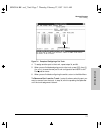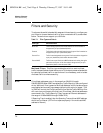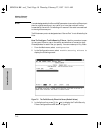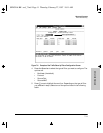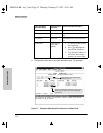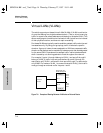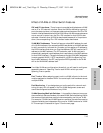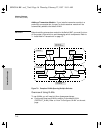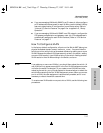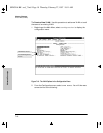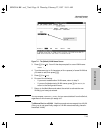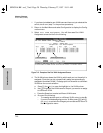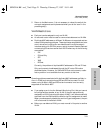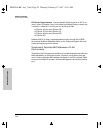
7-15
Advanced Concepts
Virtual LANs (VLANs)
Advanced Concepts
Effect of VLANs on Other Switch Features
IPX and IP Interfaces. There is a one-to-one relationship between a VLAN
and an IP or IPX network interface. Since the VLAN is defined by a group of
ports, the state (up/down) of those ports determines the state of the IP or IPX
network interface associated with that VLAN. When a VLAN comes up because
one or more of its ports is up, the IP or IPX interface for that VLAN is also
activated. Likewise, when a VLAN is deactivated because all of its ports are
down, the corresponding IP or IPX interface is also deactivated.
VLAN MAC Addresses. The switch has one unique MAC address for each
of its VLAN interfaces. You can send an 802.2 test packet to this MAC address
to verify connectivity to the switch. Likewise, you can assign an IP address to
the VLAN interface, and when you Ping that address, ARP will resolve the IP
address to this MAC address. (For IPX networks, each VLAN interface is
automatically assigned a node address that is equivalent to the MAC address
for that VLAN interface.) The switch allows up to eight VLAN MAC addresses
(one per possible VLAN). If STP is enabled for a VLAN, the Spanning Tree
source MAC address in the STP configuration BPDU packets for the VLAN
will be the VLAN MAC address itself.
Note If multiple VLANs are configured on the switch, you will need to configure a
separate instance of Spanning Tree for each VLAN in which you want
Spanning Tree to operate.
Port Trunks. When assigning a port trunk to a VLAN, all ports in the trunk
must be assigned to the same VLAN. You cannot split trunk members across
multiple VLANs.
Port Monitoring. If you designate a port on the switch for network moni-
toring, this port will not appear in the Port VLAN Assignment screen and
cannot be configured as a member of any VLAN.
VLANs Spanning Multiple Switches. It is possible to have ports on more
than one switch that are members of the same VLAN. Switches having VLANs
that cross multiple switches must be interconnected by one link per VLAN.
For example, if VLAN A and VLAN B span two switches, the switches must be
interconnected by two independent links; one for VLAN A and one for VLAN
B. This concept is illustrated in figure 7-9 on the next page.
SEDONA.BK : sed_7.fm5 Page 15 Thursday, February 27, 1997 10:11 AM



